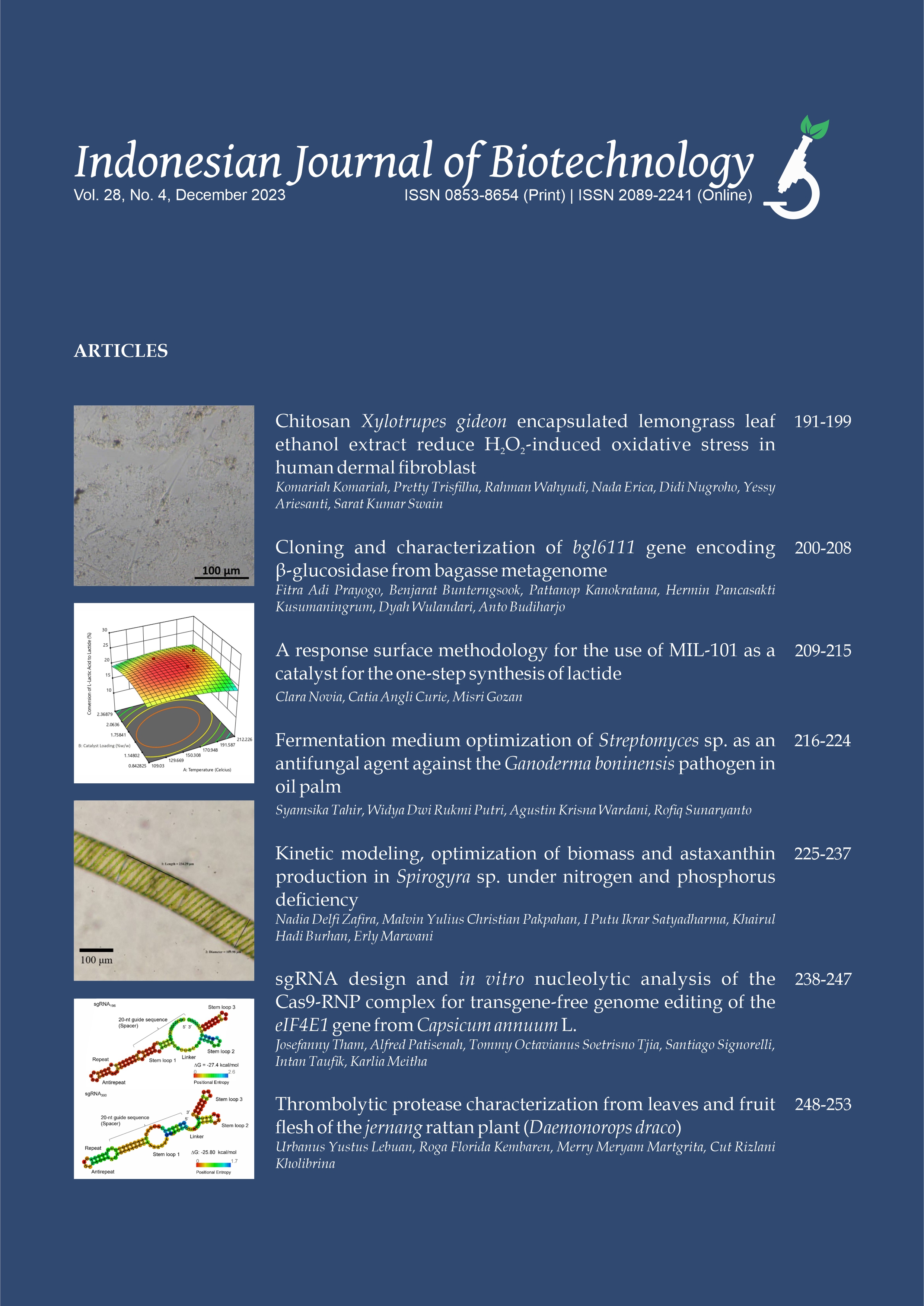The synergistic effect of doxorubicin and ethanolic extracts of Caesalpinia sappan L. wood and Ficus septica Burm. f. leaves on viability, cell cycle progression, and apoptosis induction of MCF7 cells
Sari Haryanti(1), Suwijiyo Pramono(2), Retno Murwanti(3), Edy Meiyanto(4*)
(1) Balai Besar Penelitian dan Pengembangan Tanaman Obat dan Obat Tradisional, Kementerian Kesehatan Republik Indonesia, Tawangmangu
(2) Departement of Pharmaceutical Biology, Faculty of Pharmacy, Universitas Gadjah Mada, Yogyakarta
(3) Departement of Pharmacology and Clinical Pharmacy, Faculty of Pharmacy, Universitas Gadjah Mada, Yogyakarta
(4) Departement of Pharmaceutical Chemistry, and Cancer Chemoprevention Research Center, Faculty of Pharmacy, Universitas Gadjah Mada, Yogyakarta
(*) Corresponding Author
Abstract
Keywords
Full Text:
PDFReferences
AbuHammad, S., Zihlif, M., 2013. Gene expression alterations in doxorubicin resistant MCF7 breast cancer cell line. Genomics 101, 213–220. doi:10.1016/j.ygeno.2012.11.009
Anampa, J., Makower, D., Sparano, J.A., 2015. Progress in adjuvant chemotherapy for breast cancer: an overview. BMC Med. 13, 195. doi:10.1186/s12916-015-0439-8
Asghar, U., Witkiewicz, A.K., Turner, N.C., Knudsen, E.S., 2015. The history and future of targeting cyclin-dependent kinases in cancer therapy. Nat. Rev. Drug Discov. 14, 130–146. doi:10.1038/nrd4504
Barnum, K.J., O’Connell, M.J., 2014. Cell Cycle Regulation by Checkpoints. Methods Mol. Biol. Clifton NJ 1170, 29–40. doi:10.1007/978-1-4939-0888-2_2
Carrassa, L., 2013. Cell cycle, checkpoints and cancer. Atlas Genet. Cytogenet. Oncol. Haematol. doi:10.4267/2042/52080
Cathcart, J., Pulkoski-Gross, A., Cao, J., 2015. Targeting matrix metalloproteinases in cancer: Bringing new life to old ideas. Genes Dis. 2, 26–34. doi:10.1016/j.gendis.2014.12.002
Chemler, S., 2009. Phenanthroindolizidines and Phenanthroquinolizidines: Promising Alkaloids for Anti-Cancer Therapy. Curr. Bioact. Compd. 5, 2–19. doi:10.2174/157340709787580928
Chou, T.C., 2010. Drug combination studies and their synergy quantification using the Chou-Talalay method. Cancer Res. 70, 440–446. doi:10.1158/0008-5472.CAN-09-1947
Deep, G., Agarwal, R., 2008. New Combination Therapies with Cell Cycle Agents. Curr. Opin. Investig. Drugs Lond. Engl. 2000 9, 591–604.
Dumontet, C., Jordan, M.A., 2010. Microtubule-binding agents: a dynamic field of cancer therapeutics. Nat. Rev. Drug Discov. 9, 790–803. doi:10.1038/nrd3253
Ghavami, S., Hashemi, M., Ande, S.R., Yeganeh, B., Xiao, W., Eshraghi, M., Bus, C.J., Kadkhoda, K., Wiechec, E., Halayko, A.J., Los, M., 2009. Apoptosis and cancer: mutations within caspase genes. J. Med. Genet. 46, 497–510. doi:10.1136/jmg.2009.066944
Hoesel, B., Schmid, J.A., 2013. The complexity of NF-κB signaling in inflammation and cancer. Mol. Cancer 12, 86. doi:10.1186/1476-4598-12-86
Kelley, M.R., Logsdon, D., Fishel, M.L., 2014. Targeting DNA repair pathways for cancer treatment: what’s new? Future Oncol. Lond. Engl. 10, 1215–1237. doi:10.2217/fon.14.60
Ko, E.Y., Moon, A., 2015. Natural Products for Chemoprevention of Breast Cancer. J. Cancer Prev. 20, 223–231. doi:10.15430/JCP.2015.20.4.223
Kummar, S., Chen, H.X., Wright, J., Holbeck, S., Millin, M.D., Tomaszewski, J., Zweibel, J., Collins, J., Doroshow, J.H., 2010. Utilizing targeted cancer therapeutic agents in combination: novel approaches and urgent requirements. Nat. Rev. Drug Discov. 9, 843–856. doi:10.1038/nrd3216
Lal, S., Mahajan, A., Ning Chen, W., Chowbay, B., 2010. Pharmacogenetics of target genes across doxorubicin disposition pathway: a review. Curr. Drug Metab. 11, 115–128.
Meiyanto, E., Hermawan, A., Anindyajati, A., 2012. Natural Products for Cancer-Targeted Therapy: Citrus Flavonoids as Potent Chemopreventive Agents. Asian Pac. J. Cancer Prev. 13, 427–436. doi:10.7314/APJCP.2012.13.2.427
Mekala, K., Radha, R., 2015. A Review on Sappan Wood-A Therapeutic Dye Yielding Tree. Res. J. Pharmacogn. Phytochem. 7, 227. doi:10.5958/0975-4385.2015.00035.7
Nirmal, N.P., Rajput, M.S., Prasad, R.G.S.V., Ahmad, M., 2015. Brazilin from Caesalpinia sappan heartwood and its pharmacological activities: A review. Asian Pac. J. Trop. Med. 8, 421–430. doi:10.1016/j.apjtm.2015.05.014
Nugroho, A.E., Akbar, F.F., Wiyani, A., Sudarsono, 2015. Cytotoxic Effect and Constituent Profile of Alkaloid Fractions from Ethanolic Extract of Ficus septica Burm. f. Leaves on T47D Breast Cancer Cells. Asian Pac. J. Cancer Prev. APJCP 16, 7337–7342.
Nugroho, A.E., Hermawan, A., Putri, D.D.P., Novika, A., Meiyanto, E., 2013. Combinational effects of hexane insoluble fraction of Ficus septica Burm. F. and doxorubicin chemotherapy on T47D breast cancer cells. Asian Pac. J. Trop. Biomed. 3, 297–302. doi:10.1016/S2221-1691(13)60066-0
Nugroho, A.E., Ikawati, M., Hermawan, A., Putri, D.D.P., Meiyanto, E., 2011. Cytotoxic Effect of Ethanolic Extract Fractions of Indonesia Plant Ficus septica Burm. F. on Human Breast Cancer T47D cell lines. Int. J. Phytomedicine 3, 216–226.
Nurzijah, I., Putri, D.D.P., Rivanti, E., Meiyanto, E., 2012. Secang (Caesalpinia sappan L.) Heartwood Ethanolic Extract Shows Activity as Doxorubicin Co-chemotherapeutic Agent by Apoptotis Induction on T47D Breast Cancer Cells 3, 377–384.
Santarpia, L., Lippman, S.L., El-Naggar, A.K., 2012. Targeting the Mitogen-Activated Protein Kinase RAS-RAF Signaling Pathway in Cancer Therapy. Expert Opin. Ther. Targets 16, 103–119. doi:10.1517/14728222.2011.645805
Sekti, D.A., Mubarok, M.F., Armandani, I., Junedy, S., Meiyanto, E., 2010. Ekstrak etanolik daun awar-awar (Ficus septica Burm. f.) memacu apoptosis sel kanker payudara MCF-7 melalui penekanan ekspresi Bcl-2. Maj. Obat Tradis. 15, 100–104.
Takeuchi, K., Ito, F., 2011. Receptor tyrosine kinases and targeted cancer therapeutics. Biol. Pharm. Bull. 34, 1774–1780.
Tuorkey, M.J., 2014. Curcumin a potent cancer preventive agent: Mechanisms of cancer cell killing. Interv. Med. Appl. Sci. 6, 139–146. doi:10.1556/IMAS.6.2014.4.1
Vejpongsa, P., Yeh, E.T.H., 2014. Prevention of Anthracycline-Induced Cardiotoxicity: Challenges and Opportunities. J. Am. Coll. Cardiol. 64, 938–945. doi:10.1016/j.jacc.2014.06.1167
Wang, Z., Wang, F., Tang, T., Guo, C., 2012. The role of PARP1 in the DNA damage response and its application in tumor therapy. Front. Med. 6, 156–164. doi:10.1007/s11684-012-0197-3
Weaver, A.N., Yang, E.S., 2013. Beyond DNA Repair: Additional Functions of PARP-1 in Cancer. Front. Oncol. 3. doi:10.3389/fonc.2013.00290
Witsch, E., Sela, M., Yarden, Y., 2010. Roles for Growth Factors in Cancer Progression. Physiol. Bethesda Md 25, 85–101. doi:10.1152/physiol.00045.2009
Wong, R.S., 2011. Apoptosis in cancer: from pathogenesis to treatment. J. Exp. Clin. Cancer Res. 30, 1–14. doi:10.1186/1756-9966-30-87
Article Metrics
Refbacks
- There are currently no refbacks.
Copyright (c) 2016 The Author(s)

This work is licensed under a Creative Commons Attribution-ShareAlike 4.0 International License.









